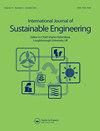Effect of gas pressure and clamping pressure on interfacial contact resistance of a cylindrical polymer electrolyte membrane fuel cell
IF 3.6
Q3 GREEN & SUSTAINABLE SCIENCE & TECHNOLOGY
International Journal of Sustainable Engineering
Pub Date : 2021-10-07
DOI:10.1080/19397038.2021.1986592
引用次数: 1
Abstract
ABSTRACT Cylindrical polymer electrolyte membrane fuel cells are promising energy conversion devices for next generation transportation applications because of their high volumetric and gravimetric power densities. The present study is focused to evaluate the effect of a design parameter (clamping pressure) and an operational parameter (gas pressure) on the contact resistance of the cell. The cell is modelled to visualise contact pressure at the interface of the gas diffusion layer and the current collector. It is observed that the contact pressure at the interface is dependent on both clamping as well as gas pressure. The ohmic resistance of the cell is found to decrease with increase in current, reaches a minimum and then increases owing to membrane hydration and dehydration over gradual increase in the cell temperature. The threshold contact resistance is then calculated to be 33.21 mΩ cm2 based on the minimum ohmic resistance of 100 mΩ. The study highlights the optimum zone where the combination of both clamping and gas pressures can be used to minimise the contact resistance.气体压力和夹紧压力对圆柱形聚合物电解质膜燃料电池界面接触电阻的影响
圆柱形聚合物电解质膜燃料电池由于其高体积和重量功率密度,是下一代交通运输应用中很有前途的能量转换设备。本研究的重点是评估设计参数(夹紧压力)和操作参数(气体压力)对电池接触电阻的影响。对电池进行建模,以可视化气体扩散层和集流器界面处的接触压力。观察到,界面处的接触压力既取决于夹紧,也取决于气体压力。发现电池的欧姆电阻随着电流的增加而降低,达到最小值,然后由于膜的水合作用和脱水而随着电池温度的逐渐升高而增加。然后根据最小欧姆电阻100 mΩ计算出阈值接触电阻为33.21 mΩ cm2。该研究强调了夹紧和气体压力的组合可以用来最小化接触阻力的最佳区域。
本文章由计算机程序翻译,如有差异,请以英文原文为准。
求助全文
约1分钟内获得全文
求助全文
来源期刊

International Journal of Sustainable Engineering
GREEN & SUSTAINABLE SCIENCE & TECHNOLOGY-
CiteScore
7.70
自引率
0.00%
发文量
19
 求助内容:
求助内容: 应助结果提醒方式:
应助结果提醒方式:


